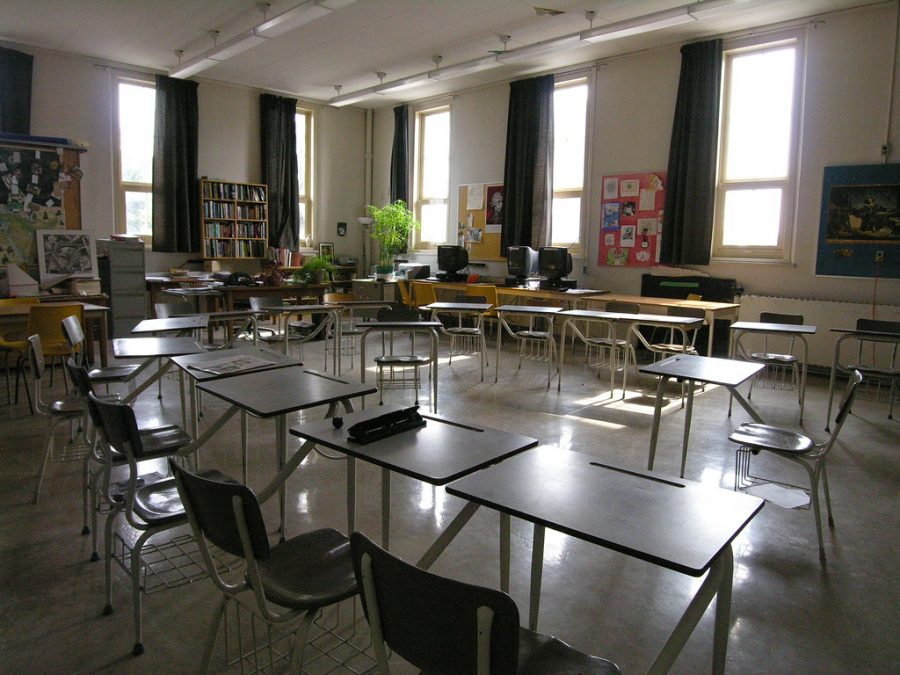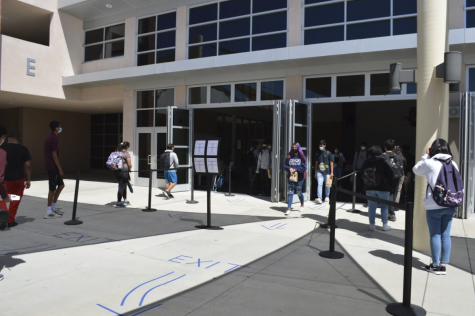CUSD vs FUHSDs reopening plan
Examining similarities and differences in CUSDs reopening plan compared with FUHSDs
“classroom 2nd fl” by cayoup is licensed with CC BY-NC-SA 2.0. To view a copy of this license, visit https://creativecommons.org/licenses/by-nc-sa/2.0/
On Feb. 26, Cupertino Union School District (CUSD) hosted a board meeting in which parents argued for in-person school to reopen. Just over a week later, California Gov. Gavin Newsom offered a cash incentive to any school district that reopened in the coming month.
CUSD’s plan consisted of opening schools on March 26 and allowing teachers to come back a week earlier to prepare classrooms. Students who elected to return to in person learning would be separated into two cohorts: cohort A would attend school two days a week for approximately four hours, while cohort B would attend school the other two days for the same timeframe. Following spring break, CUSD moved to a four day per week per cohort schedule.
FUHSD’s plan consisted of a similar two cohort plan, but also included a full week plan, where students could attend in person for either four days a week or two days a week. Unlike CUSD, the FUHSD plan allowed students to return to campus for the entire school day. FUHSD schools also reopened after spring break on April 17一 almost a month later than CUSD.
According to English teacher Lynn Rose, teachers were given the option to teach asynchronously on the Thursday and Friday prior to spring break to prepare for in person learning. Additionally, teachers were allowed to access their classrooms during spring break and were offered ten additional paid hours to set up their classroom, something that Rose found extremely useful.
In stark contrast, while CUSD teachers were also given the option to teach asynchronously for two days, teachers were not given an extra week as their reopening plan occurred well before spring break. Additionally, teachers were not given paid hours, which according to Murdock Portal teacher Ameilia Drake, meant that she would still have to do the work, it would just be unpaid.
“There’s more work than a human could do,” Drake said. “Any help that you could get would have been super helpful.”
Rose agrees with Drake, adding that without spring break, much of the work needed to set up classrooms would not have been done or would have been rushed.
“I think all of us appreciated that Mr. Clautnitzer and the district was giving us that [extra] time,” Rose said. “I think it was also just about the acknowledgment that the district and admin understood that this transition was not going to be something that was just automatic or easy for teachers. So by granting us that time, that helped us feel understood and validated.”
One way or another, teachers at both districts managed to assemble their classroom in time for students to arrive on campus. Junior Kyle Zhao is one of the students who opted for the four-day plan upon his return to MVHS, and while he did not see an improvement in the quality of the education, he believes that for some students, better focus at school can be achieved. In contrast to Bhandari, Zhao feels that he was not given the option to return to school, instead, he felt as if his parents signed him up for returning.
“I didn’t really know too many people who came back,” Zhao said. “I was a bit nervous, [especially when] the school said your computer needed six hours of charge and going back to school in general…was scary.”
Zhao believes that socially, returning to in person learning was beneficial to him.
“I talk to more people and I get to talk to my classmates a little more,” Zhao said. “ [Academically, going back], is not necessarily beneficial [in my opinion] — I guess I focus slightly better because you can’t search up stuff and do whatever you want behind your computer, but I would say it has helped [in terms of] getting to know the teacher better.”
Unlike Zhao, eighth grader and Lawson Middle School student Noor Bhandari was excited to go back on campus and see her friends.
“It was interesting because obviously, everyone was in masks and you have to be distanced six feet apart,” Bhandari said. “It was really nice to see people in person and see actual faces again.”
Secretary at Lawson Middle School and parent of Bhandari, Preetika Ranu said that the decision to send Noor back was mainly a social one, not based on academics.
“This year was so hard and difficult for Noor, it was more because of the lack of connection with friends,” Ranu said. “It was more of the social piece. Over the summer, she did lose out on a group of besties so that was very hard for us. Keeping that in mind, when the option did open up…we felt like it was safe enough to go back to school.”
However, after initially returning to in-person learning, Ranu and her family eventually made the decision to pull Bhandari from in person learning into distance learning. While the decision was made in part to ease her dance schedule, it was also made because of some concern over the safety of schools.
As the attendance secretary, Ranu says that she’s seen a lot of changes and concerns from parents as they have moved back into in person learning.
“We have seen a lot of kids being pulled back from the hybrid model into online [learning],” Ranu said. “The reason that I’m seeing floating around [is] primarily due to COVID[-19] and they do feel like it’s too much.”
In terms of health and safety, both districts have mandated contact tracing, social distancing and mask wearing, all of which, according to the CDC, help limit and contain the spread of COVID-19.
“It’s really impossible to be ready,” Drake said. “It’s really impossible to teach two groups of kids [at the same time] and manage half in the room and half at home. But I feel like we talked about reopening for so long, that it was always in the back of my mind…I can’t say that the reopening was rushed [because] it was just changed.”





